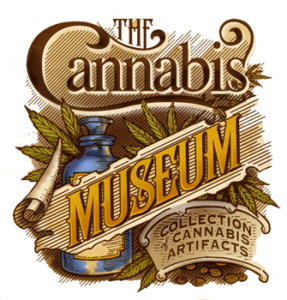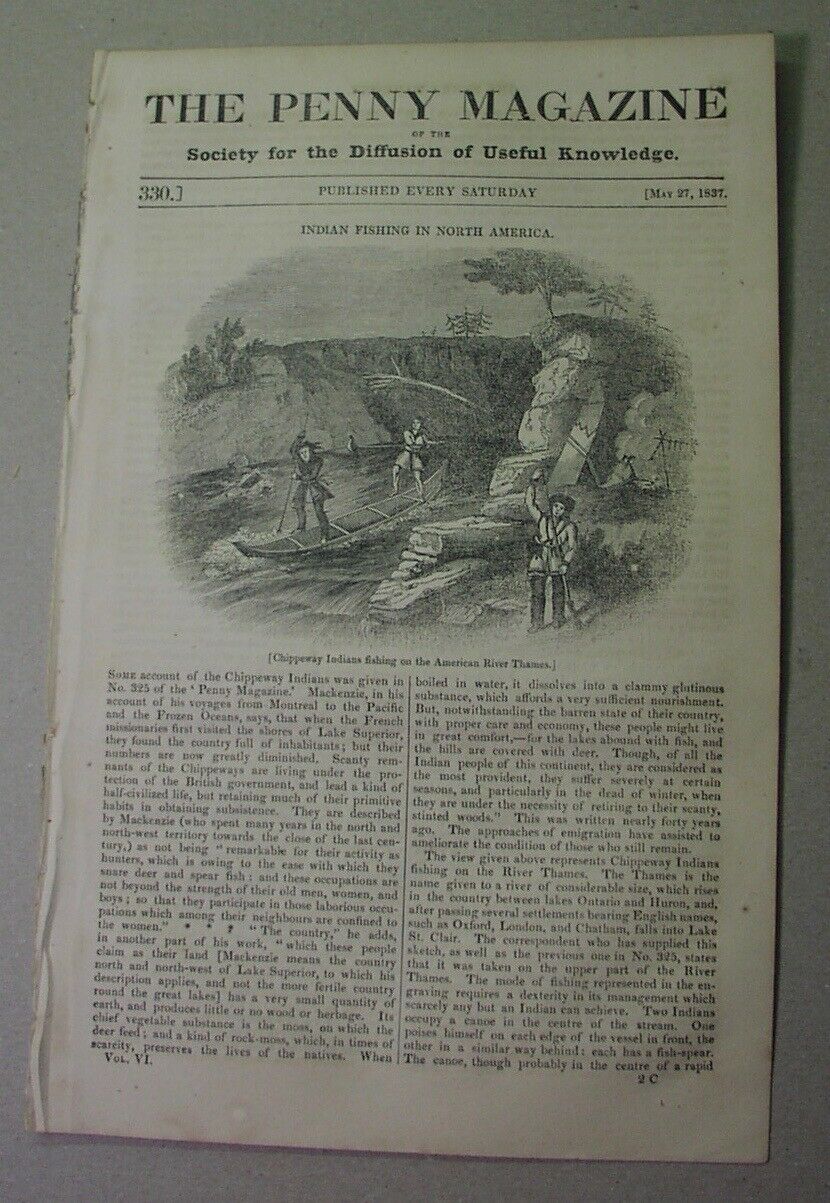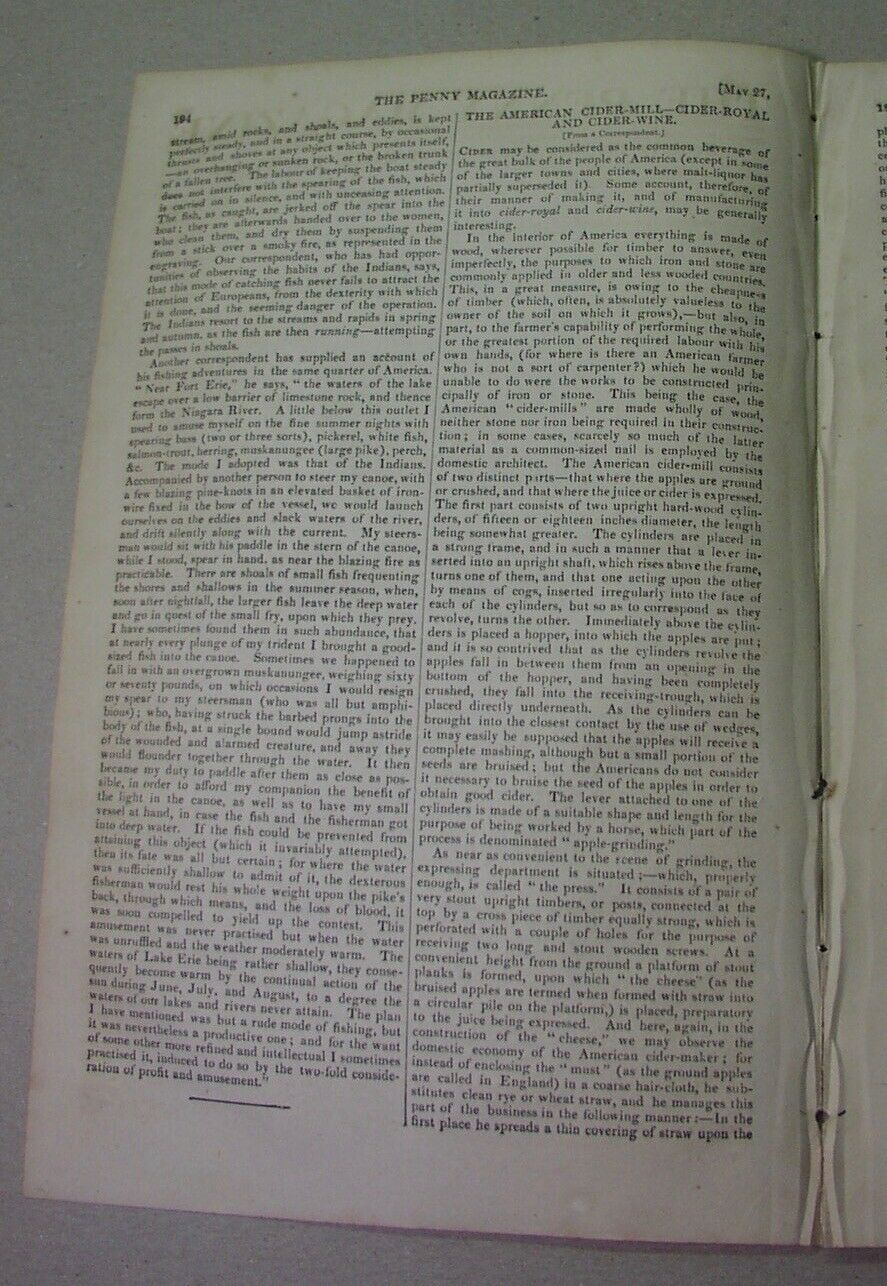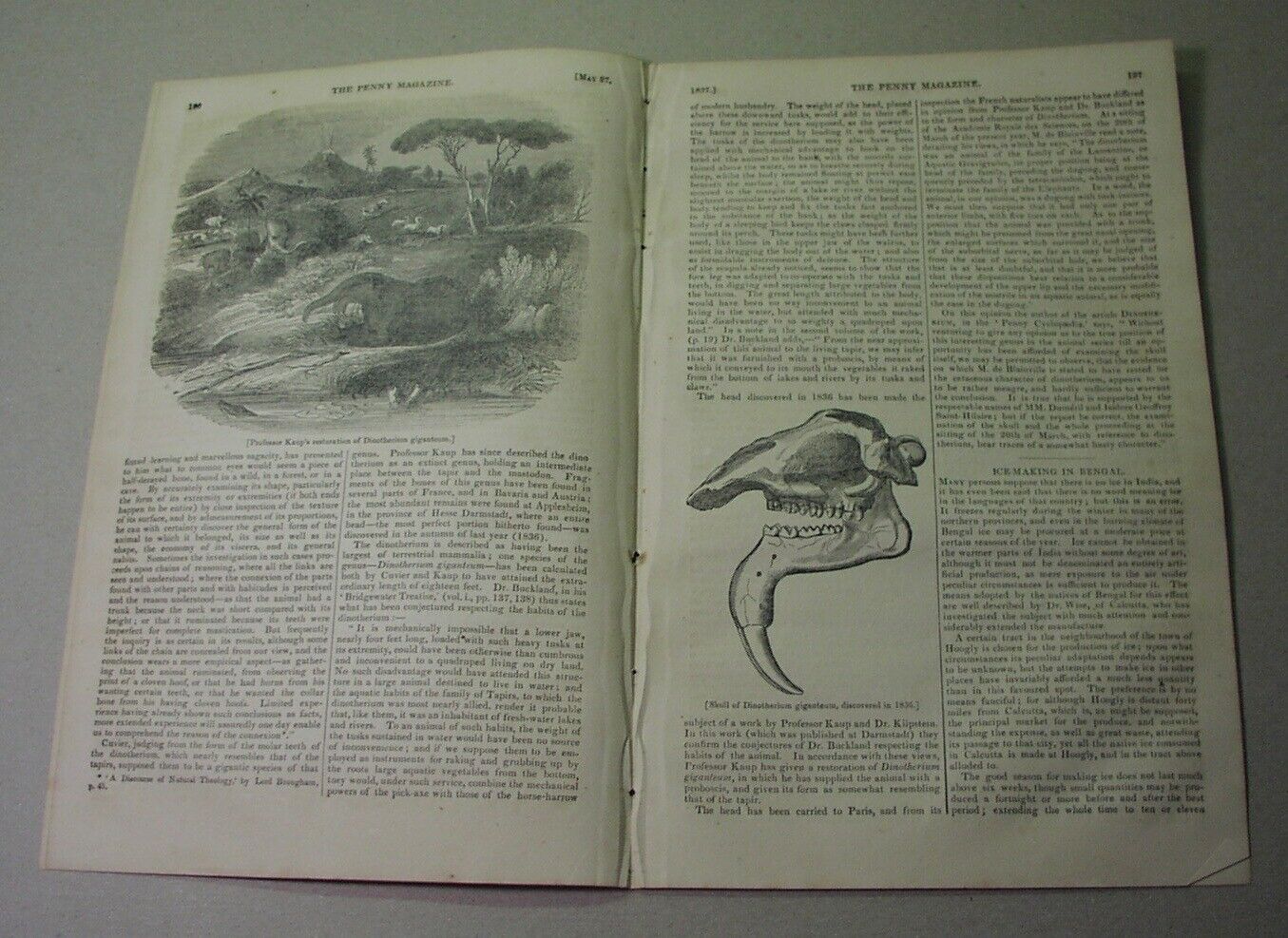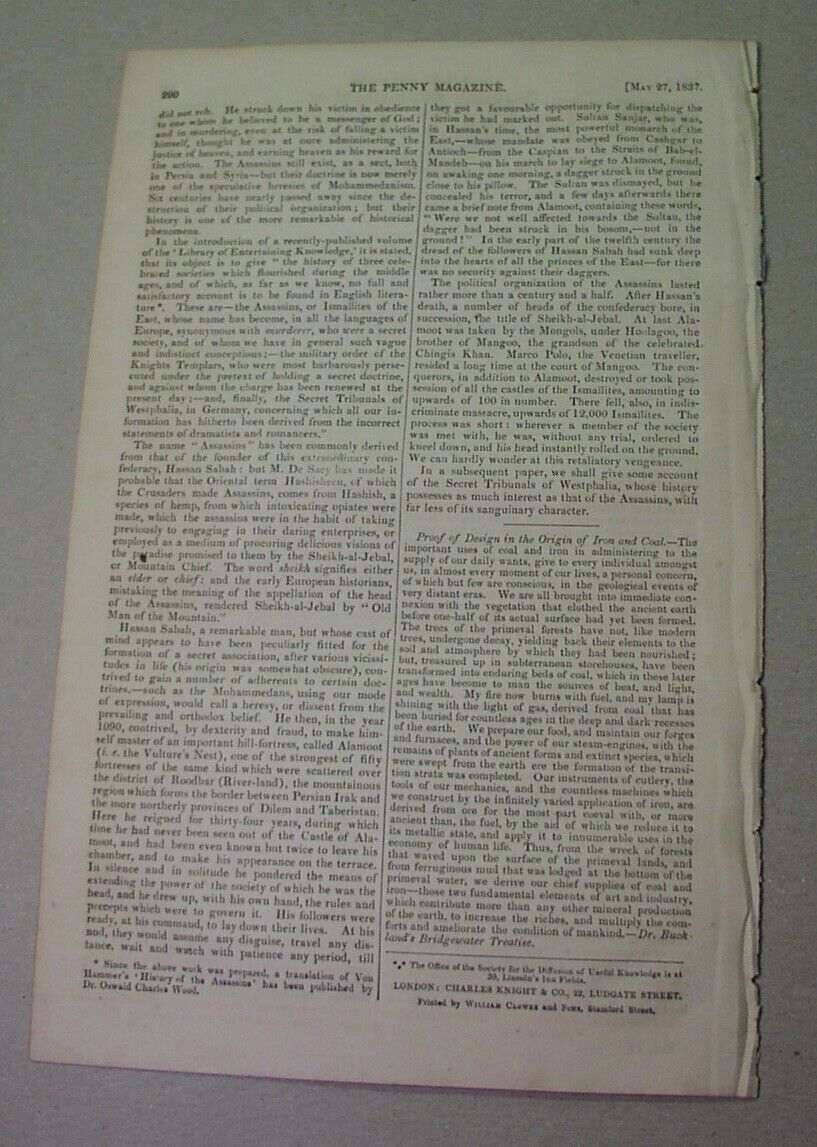The Penny Magazine
Dublin Core
Title
Description
Discusses the importance of growing hemp. different countries and their hemp in comparison to Russia who produces the most and the best hemp. how hard it is to keep up with the demand for hemp.
Date
Language
Format
Magazine Item Type Metadata
Volume
II
Pages
8
Condition
fair- slightly aged
Notes
this article mentions the Cape of Good Hope- "Hottentots" were cultivating hemp. States" This is a plant used universally in this country, though for a purpose very different from that to witch it is applied by the industrious Europeans. The Hottentot loves nothing so well as tobacco and with no other thing can he be so easily enticed into servitude ; but for smoking he finds tobacco not sufficiently strong, and therefore mixes it with hemp chopped very fine."
Seller ID
Seller Notes
THE PENNY MAGAZINE
May 27, 1837
Chippewa Indians - muskellunge
cider in America
pre-elephant fossils
India Thuggees & Assassins
This is a paper which is over 180 years old. It is printed in a small format, measuring 7” by 11” in size, and is 8 pages long. The paper came from a bound volume and has typical minor disbinding marks at the spine, plus a slight bit of age browning, but is still in excellent and attractive condition.
The lead article is on INDIAN FISHING IN NORTH AMERICA. The story is a page and a half long, and nicely illustrated with an attractive wood engraving on the cover of “Chippeway Indians fishing on the American River Thames.”
Much of the text describes how the Chippewa Indians fish in Ontario, Canada. It says, in part:
“Scanty remnants of the Chippeways are living under the protection of the British government, and lead a kind of half-civilized life, but retaining much of their primitive habits in obtaining subsistence. They are . . . . ‘remarkable for their activity as hunters, which is owing to the ease with which they snare deer and spear fish . . . . of all the Indian people of this continent, they are considered as the most provident. . . .’
“The view given represents Chippeway Indians fishing on the River Thames . . . . a river of considerable size, which rises in the country between lakes Ontario and Huron, and . . . . falls into Lake St. Clair. . . . The mode of fishing . . . . requires a dexterity in its management which scarcely any but an Indian can achieve. Two Indians occupy a canoe in the centre of the stream. . . .” Etc.
The article concludes with a first-hand account of a correspondent fishing near Fort Erie, who writes:
“I used to amuse myself on this fine summer nights with spearing bass (two or three sorts), pickerel, white fish, salmon-trout, herring, muskanungee (large pike), perch, &c. The mode I adopted was that of the Indians. . . . Sometimes we happened to fall in with an overgrown muskanungee, weighing sixty or seventy pounds . . . . my steersman . . . . having struck the barbed prongs into the body of the fish, at a single bound would jump astride of the wounded and alarmed creature . . . .” Etc.
Following this is an article of a page and a half (over 200 lines of text) on THE AMERICAN CIDER-MILL — CIDER ROYAL AND CIDER-WINE. It begins:
“CIDER may be considered as the common beverage of the great bulk of the people of America (except in some of the larger towns and cities, where malt-liquor has partially superseded it). Some account, therefore, of their manner of making it, and of manufacturing it into cider-royal and cider-wine, may be generally interesting.”
In the center of the issue is a 2-page scientific article on THE DINOTHERIUM, which includes two wood engravings, captioned: “Professor Kaup's restoration of Dinotherium giganteum”; and “Skull of Dinotherium giganteum, discovered in 1836.” The story is about the discovery by Professor Kaup of the first fossil remains of Deinotherium, a prehistoric relative of the modern elephant, and Kaup's assembly of its the bones. Dinotherium is the third largest land mammal known to have existed, and at the time of this article it was thought to be the largest, so the article describes a significant advance in palentology.
The paper also contains two sizeable articles related to India, on ICE-MAKING IN BENGAL (about 175 lines of text) and SECRET SOCIETIES OR FRATERNITIES (over 200 lines), which describes the Thuggees of India, as well as gives some history of the Assassins and their founder Hassan Sabah. It contains an interesting historical drug reference on HASHISH, saying that, “the Oriental term Hashisheen, of which the Crusaders made Assassins, comes from Hashish, a species of hemp, from which intoxicating opiates were made, which the assassins were in the habit of taking previously to engaging in their daring enterprises. . . .”
Background on this publication: The Penny Magazine was a weekly 8-page paper put out by London’s “Society for the Diffusion of Useful Knowledge.” Throughout the 1830s, an American edition was very popular in the United States, only to dwindle into extinction during the following decade. The paper did not cover the current news of the day, and carried no advertising. Instead, the Penny Magazine provided excellent essays on a wide array of subjects, such as architecture, science, geography and natural history. The paper was compact in size, and most issues were illustrated with several fine woodcut engravings.
May 27, 1837
Chippewa Indians - muskellunge
cider in America
pre-elephant fossils
India Thuggees & Assassins
This is a paper which is over 180 years old. It is printed in a small format, measuring 7” by 11” in size, and is 8 pages long. The paper came from a bound volume and has typical minor disbinding marks at the spine, plus a slight bit of age browning, but is still in excellent and attractive condition.
The lead article is on INDIAN FISHING IN NORTH AMERICA. The story is a page and a half long, and nicely illustrated with an attractive wood engraving on the cover of “Chippeway Indians fishing on the American River Thames.”
Much of the text describes how the Chippewa Indians fish in Ontario, Canada. It says, in part:
“Scanty remnants of the Chippeways are living under the protection of the British government, and lead a kind of half-civilized life, but retaining much of their primitive habits in obtaining subsistence. They are . . . . ‘remarkable for their activity as hunters, which is owing to the ease with which they snare deer and spear fish . . . . of all the Indian people of this continent, they are considered as the most provident. . . .’
“The view given represents Chippeway Indians fishing on the River Thames . . . . a river of considerable size, which rises in the country between lakes Ontario and Huron, and . . . . falls into Lake St. Clair. . . . The mode of fishing . . . . requires a dexterity in its management which scarcely any but an Indian can achieve. Two Indians occupy a canoe in the centre of the stream. . . .” Etc.
The article concludes with a first-hand account of a correspondent fishing near Fort Erie, who writes:
“I used to amuse myself on this fine summer nights with spearing bass (two or three sorts), pickerel, white fish, salmon-trout, herring, muskanungee (large pike), perch, &c. The mode I adopted was that of the Indians. . . . Sometimes we happened to fall in with an overgrown muskanungee, weighing sixty or seventy pounds . . . . my steersman . . . . having struck the barbed prongs into the body of the fish, at a single bound would jump astride of the wounded and alarmed creature . . . .” Etc.
Following this is an article of a page and a half (over 200 lines of text) on THE AMERICAN CIDER-MILL — CIDER ROYAL AND CIDER-WINE. It begins:
“CIDER may be considered as the common beverage of the great bulk of the people of America (except in some of the larger towns and cities, where malt-liquor has partially superseded it). Some account, therefore, of their manner of making it, and of manufacturing it into cider-royal and cider-wine, may be generally interesting.”
In the center of the issue is a 2-page scientific article on THE DINOTHERIUM, which includes two wood engravings, captioned: “Professor Kaup's restoration of Dinotherium giganteum”; and “Skull of Dinotherium giganteum, discovered in 1836.” The story is about the discovery by Professor Kaup of the first fossil remains of Deinotherium, a prehistoric relative of the modern elephant, and Kaup's assembly of its the bones. Dinotherium is the third largest land mammal known to have existed, and at the time of this article it was thought to be the largest, so the article describes a significant advance in palentology.
The paper also contains two sizeable articles related to India, on ICE-MAKING IN BENGAL (about 175 lines of text) and SECRET SOCIETIES OR FRATERNITIES (over 200 lines), which describes the Thuggees of India, as well as gives some history of the Assassins and their founder Hassan Sabah. It contains an interesting historical drug reference on HASHISH, saying that, “the Oriental term Hashisheen, of which the Crusaders made Assassins, comes from Hashish, a species of hemp, from which intoxicating opiates were made, which the assassins were in the habit of taking previously to engaging in their daring enterprises. . . .”
Background on this publication: The Penny Magazine was a weekly 8-page paper put out by London’s “Society for the Diffusion of Useful Knowledge.” Throughout the 1830s, an American edition was very popular in the United States, only to dwindle into extinction during the following decade. The paper did not cover the current news of the day, and carried no advertising. Instead, the Penny Magazine provided excellent essays on a wide array of subjects, such as architecture, science, geography and natural history. The paper was compact in size, and most issues were illustrated with several fine woodcut engravings.
Order ID
273680612911-0!160000287617779
Collection
Citation
“The Penny Magazine,” Wirtshafter Collection-Cannabis Museum-Athens, Ohio, accessed June 7, 2025, https://cannabismuseum.com/omeka/items/show/5704.
